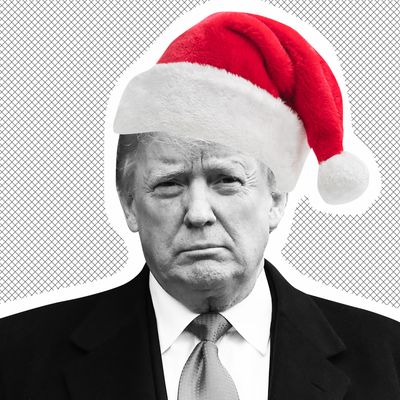
This Christmas, reports ABC News, President Trump “did the unthinkable.”
The story wasn’t about the president pulling troops out of Syria, or criticizing the chairman of the Federal Reserve, or shutting down the government. It wasn’t even about letting immigrant children die in U.S. custody — although it did involve a child. The story was about the president’s phone call with a 7-year-old girl from Lexington, South Carolina.
Trump asked young Collman Lloyd if she was “still a believer in Santa Claus,” adding that at her age, such a belief would be “marginal.” He seemed to be suggesting that at 7, most children could be expected to question the myth of a jolly North Pole dweller who magically flies around the entire world in one night, distributing gifts. (According to NPR, he was off by two years: Children stop believing in Santa at around nine.)
The hue and cry went up at once. How could a grandfather even think of puncturing a child’s innocent belief in Santa Claus? What kind of monster was he? Of course, Trump has never shown a particular gift for talking to children. Recall his previous gaffes on Halloween and at a 2017 Boy Scouts convention. But the Santa Claus story felt different. Notably, the myth of Santa — and the way it must be preserved at all costs — illuminates something about our own current political moment.
The whole Santa Claus thing has always troubled me, specifically the grand, collective demand it places on adults to lie to children. In this, Santa Claus occupies a rarefied category of children’s story, adjacent to but more pervasive than the Tooth Fairy and the Easter Bunny. Unlike, say, Cinderella, Snow White, or Little Red Riding Hood, Santa is presented as a real, historical person, with relevance in families’ lives. Many parents go to great lengths to convince their children that a single, beneficent man literally enters everyone’s home on Christmas, distributing the whole world’s gifts. This is compounded by all the costumed department-store Santas who help bamboozle children (sweetly) into buying this unlikely story.
But there’s a third group created by the Santa myth: the rest of us. The inevitable bystanders who risk endangering the whole pageant — adults who might stumble into a family Christmas unaware that the children believe in Santa, and inadvertently blurt out the truth. Even other children — more knowledgeable schoolmates or friends — pose a threat to the Santa myth, possibly cluing in their more gullible little friends. The point is, the fantastical story of Santa Claus is always a precarious endeavor. It takes a village — a conspiracy of silence — to sustain it.
This week Trump bulldozed his way right through the village. He didn’t outright tell the little girl that Santa Claus didn’t exist. He hedged, saying the child’s belief was “marginal,” a remark few 7–year-olds would understand anyway (this one didn’t.) The crisis that ensued, therefore, was not Collman’s but ours. And it was not just the result of America’s righteous parental indignation or its respect for Christmas traditions.
The outrage here feels deeper. I think it stems from just how closely the Santa myth actually mirrors the Trump myth, especially in the degree of dissembling and willful blindness it takes to sustain the fantasy surrounding this president. Think about it: Like Santa, Trump purports to be able, single-handedly, to take care of everything, to bring prosperity, to magically make America “great again.” How is this so different from the belief that one man can encircle the globe with flying reindeer?
Consider Trump’s famous declaration “I alone can fix it” or his conviction that his untutored instinct — his “gut” — is more accurate than most people’s “brains.” Only someone who believed in magic could accept such assertions. Most of us know this, and continue to wait, uncomfortably, for the ultimate debunking of this fiction. And we see that discomfort mirrored on the faces of those working the hardest to uphold the myth of Old St. Trump — his supporters.
Just look at the obviously pained faces and stifled expressions on his vice-president, cabinet members, or other spineless abettors. Are those not the faces of people being coerced into upholding an obvious lie — about Trump’s competence, his good intentions, his good mental health, or even his coherence? They are all thrust into the “nervous bystander” role like the one required by the Santa myth, trying not to let the truth slip out. The Trump myth is exhausting for his supporters to maintain; it co-opts everyone around him into theatrical dissembling.
Oddly, in this context, Trump comes off as honest. When he nearly outed Santa Claus, he was doing precisely what we need the Senate and the cabinet to do immediately: Admit that the fantastical tale of one supernatural, prosperity-bringing old man is an impossible lie. This is likely what provoked all the discomfort. Viewers recognized that Trump was modeling an important action: debunking a fiction.
In fact, there is one person who has already pushed this debunking to the needed level: Former Defense Secretary James Mattis. When General Mattis resigned last week and published his astonishing letter of rebuke, he was essentially opting out of the myth-making conspiracy around this president. In this, so far, he stands alone.
Young Collman seems to have survived this phone call with her childhood fantasies intact. But it’s time for Trump’s supporters to face the truth: No, Virginia, there is no Santa Claus.

